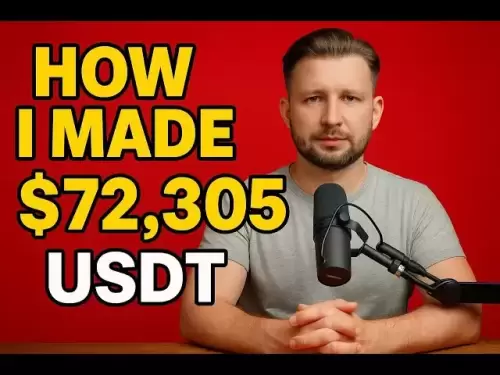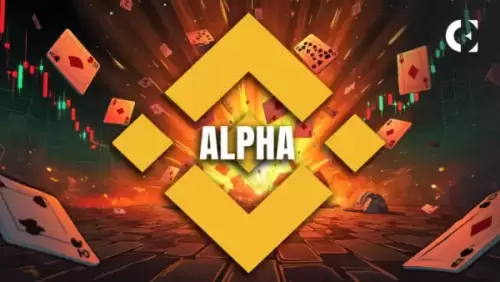 |
|
 |
|
 |
|
 |
|
 |
|
 |
|
 |
|
 |
|
 |
|
 |
|
 |
|
 |
|
 |
|
 |
|
 |
|
Cryptocurrency News Articles
After Pi Network's token crashed 25% post-announcement, crypto investors are turning to Solaxy
May 17, 2025 at 04:06 am
Pi Network has once again found itself at the centre of controversy after its latest ecosystem update seemingly backfired.

After Pi Network’s token crashed 25% post-announcement, crypto investors are turning to Solaxy – a Solana Layer-2 project with real utility and strong early backing.
Pi Network has once again found itself at the centre of controversy after its latest ecosystem update seemingly backfired. The platform had teased a major announcement, which culminated on May 14 with the unveiling of a $100 million investment initiative aimed at boosting utility and adoption of its native Pi token.
Denominated in both Pi and USD, the fund was positioned as a way to attract innovative startups into the Pi ecosystem. The news initially triggered bullish momentum, pushing the Pi token above $1.50 for the first time in two months. Speculation over a potential Binance listing added further fuel to the rally, helping Pi briefly enter the top 20 cryptocurrencies by market cap. Just 24 hours later, the price collapsed.
By early May 15, Pi had plunged more than 25% to $0.85. Market cap data from CoinGecko showed a dramatic fall from over $9 billion to $6.2 billion, knocking Pi down to 29th place in the rankings.
Investor Backlash and Strategic Misfires
The backlash has been swift. Critics on X accused Pi Network of manufacturing hype with a single overblown announcement. One user, Dao World, argued that the team failed to manage expectations, calling the reveal underwhelming and poorly timed.
“In the crypto market, such timing and presentation can backfire, especially if they don’t meet the community’s expectations,” Dao World posted, echoing a sentiment shared by many disillusioned holders.
In an attempt to calm the storm, Pi-aligned media outlet The Times of Pinetwork clarified that the focus remained on building long-term ecosystem value – not immediate price performance, but for many traders, the damage was already done.
With that, attention has quickly shifted to emerging projects offering both clear narratives and working utility – with Solaxy (SOLX) attracting some of the strongest tailwinds.
Solaxy Gains Momentum as Solana’s First Layer-2
While Pi Network faced price whiplash and strategic uncertainty, Solaxy has been busy establishing itself as a credible alternative. Aiming to become Solana’s first-ever Layer-2 (L2) solution, the project promises to resolve key limitations on the Solana mainnet, such as congestion and high failure rates during peak traffic.
The pitch is simple: faster, cheaper and more scalable transactions – especially for high-volume activity like meme coin trading and gaming dApps.
GET IN EARLY ON SOLAXY’S L2 FUTURE
Solaxy’s $SOLX token has already raised over $36.5 million in its ongoing presale. A recent whale buy of 115 million SOLX, worth $200,000, marked the project’s biggest individual transaction to date and a strong signal of growing investor confidence.
Built for Speed: The Solaxy Advantage
Unlike Pi, which continues to face scrutiny over utility and exchange listings, Solaxy has a clear infrastructure vision. Its native token $SOLX is a multi-chain asset, operating across both Ethereum and Solana. This dual compatibility offers users the best of both ecosystems – Ethereum’s liquidity and developer tools, plus Solana’s raw speed and low fees.
Upon launch, Solaxy will roll out its L2 network with a focus on solving congestion during spikes in usage – a key issue that has previously disrupted the Solana chain. Token holders will also be able to stake SOLX at an APY of 115%, with 25% of the token supply allocated specifically to staking rewards.
At a current presale price of $0.001726 and with a price increase imminent, early buyers are rushing in. Once the presale ends, the team plans to bridge the token across chains and list it on major centralized and decentralized exchanges.
Institutional Tailwinds for Solana and Solaxy
Solaxy’s success is also part of a broader resurgence in the Solana ecosystem. Just this month, the Global Dollar Network (GDN) – a Solana-aligned stablecoin consortium backed by Paxos, Robinhood and Galaxy Digital – welcomed 19 new institutional members.
GDN’s expanding footprint underscores growing institutional appetite for Solana-based projects. As L2 infrastructure gains traction across Ethereum, Solaxy’s vision to replicate that scalability model on Solana is likely to resonate with developers, investors and traders alike.
In this context, Solaxy isn’t just an alternative to Pi – it’s emerging as a foundational piece of Solana’s next phase of growth.
Pi Network Price Prediction: Downtrend Likely?
While Pi Network maintains that its $100 million fund is a long-term play, market participants seem unconvinced. The swift reversal in price suggests the rally was speculative and based more on
Disclaimer:info@kdj.com
The information provided is not trading advice. kdj.com does not assume any responsibility for any investments made based on the information provided in this article. Cryptocurrencies are highly volatile and it is highly recommended that you invest with caution after thorough research!
If you believe that the content used on this website infringes your copyright, please contact us immediately (info@kdj.com) and we will delete it promptly.
-

-

- Dogecoin (DOGE) Whales Have Been Quietly Stacking Up Their Bags for the Past 4 Weeks
- May 17, 2025 at 12:35 pm
- Fresh data published by on-chain analytics platform Santiment and highlighted by market commentator Ali Martinez reveal that the largest Dogecoin investors have spent the last four weeks quietly expanding their positions
-

-

-

-

-

-

-

- Hedera (HBAR) Finds Itself in a Critical Consolidation Phase, Hovering Between Key Support and Resistance Levels
- May 17, 2025 at 12:15 pm
- HBAR has found itself in a critical consolidation phase, hovering between key support and resistance levels. While its exponential moving averages (EMAs) continue to show a bullish structure, short-term averages are beginning to curve downward



























































